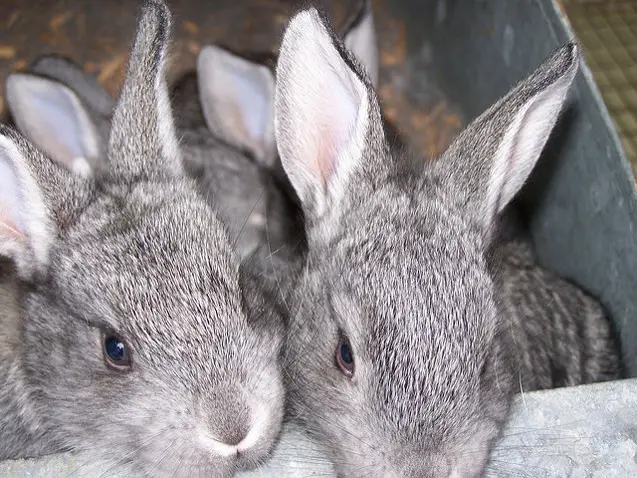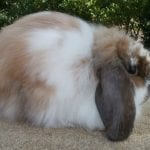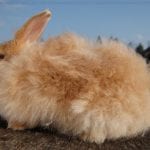Scientific Facts
| Common Name: | American Chinchilla |
| Life Span: | 5-8 years |
| Size: | Large |
| Country of Origin: | France |
Physical Description
The American Chinchilla rabbits are famous breeds. The name was taken on the alikeness of their fur to the South American rodent, which is the Chinchilla. They were primarily raised for commercial meat. These species are the most peculiar among the Chinchilla breeds. The American Chinchilla rabbits exhibit a commercial-shaped figure. They are a large kind. They weight around 9 to 12 pounds once it is completely matured. Its commercial-structure figure is on the sturdy side because this creature was firstly cultivated for their fur and meat. Their neck is short. Their head is relatively wide with short and upright ears. Its coat is spongy, abbreviated, and rollback, which does not require excessive maintenance to preserve its health. Their hair has an average length. Many rabbits shed during fall and spring, which indicates that you can see plenty of hair indoors that you commonly do. With this, you just have to brush your American Chinchilla once biweekly until it stops shedding.
There is only a single color recognized by the ARBA with this breed of rabbit, and that is the color of an authentic chinchilla. The color underneath would be dark slate blue at the fundamental part and darker blue on the top edge with a fragment of light gray at intervals. The trivial eye circles are precise and have a shade of light pearl, and the undersurface of the tail is white while the covering is mainly black with minimal white hairs. The color of the eyes can either be brown, marbled, or blue-grey; however, dark brown is preferred.
American Chinchilla rabbits are born with dark coats. As time goes by and the rabbits grow older, you will notice the coat to change and alter. They penetrate an ash tone that rounds off to a shade of blue-green at around the age of 7 months.
These rabbits rapidly became a very triumphant commercial breed in entire Europe, not only because of the alikeness of their fur to Chinchilla but because of their matured coat. These huge Chinchillas were initially recognized as the Heavyweight Chinchilla; however, in 1924, these species were acknowledged by the American Rabbit Breeders Association as an insulating, bigger breed, and was termed the American Chinchilla.
Lifespan
American Chinchilla rabbits have an average lifespan that ranges from 5 to 8 years. Nevertheless, these animals are still dependent on their environment. If they are given the best care with proper diet and habitat, then these animals can live even longer than 8 years. For owners of American Chinchillas, they should commit to taking care of these animals. They should know the best ways of raising these rabbits.
Eating Habits
American Chinchilla rabbits are known to be herbivores. They enjoy eating pellet foods, lettuce, and grass. These creatures have no tolerance to high sugar quantity; thus, their fruit consumption or sugar intake should be limited.
Sleeping Habits
American Chinchillas normally sleep in the daytime. To get enough rest, these creatures need to get undisturbed sleep for an extensive period. They are more likely to be interactive and feed mainly during night-time, where they require darkness for 12 hours. Owners should not attempt disturbing the sleep of these rabbits as it may irritate their pets. Owners should respect the sleeping pattern of their pets to make sure that they get enough rest.
Development and Reproduction
This rabbit breed was developed as an output of crossbreeding. The said crossbreeding work to enhance the current breed by conveying distinct genes that promoted a great growth rate and also the rate of fertility.
American Chinchillas are great breeders. They produce an average litter that ranges from 6 to 9 kits. They do make huge litters, and they portray exemplary mother instincts. The rabbits grow quicker and rapidly achieve market weight. These creatures are very relevant breeds for the production of commercial meat. They also have a great meat to bone ratio.
Several breeders started to scrupulously breed these species to grow their size, intending to create a more marketable rabbit with more meat and a bigger pelt.
How to Breed
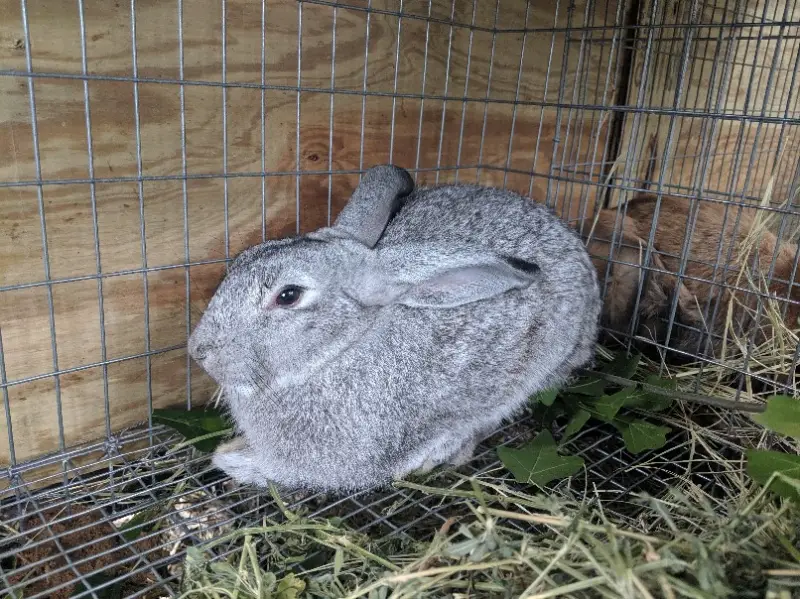
Determining the Sexes
The best method to determine the gender of your American Chinchilla is to lie it on its bottom or back to inspect its genitals. You would find it more convenient if you have someone that will gently hold the rabbit while you are checking the genitals. Male rabbits have huge testicles. These testicles are far too large to suit conveniently into the little patch of skin found in the middle of the penis and anus. Female American Chinchillas, on the other hand, are determined with their visible vulva – a pink, slit-like shape found in the middle of a convex patch of fur underneath the tail.
Courtship and Mating
In the wild, the male American Chinchilla rabbits are seen chasing the females as an act of courtship. There are times that the males and females would run after each other. This behavior is sometimes done for fun, but it is commonly done are part of the pre-eminence relationship. This is not dangerous, though. Mating happens when the male mounts on a female, although there are times that a female will mount on a male too.
Common Health Problems
Although some breeds of rabbits have health concerns about their fur, the American Chinchilla rabbits have no similar concern or any other genetic illness. Nevertheless, there are some concerns the pet rabbit parents have to be cautious about to inhibit these health issues from manifesting in the first place.
The teeth of the rabbit never cease from growing, and the only way to manage the size of their teeth is through a diet that is rich in the hay – this explains why it is critical to follow the 70 percent hay in a diet. Overgrown teeth in American Chinchilla rabbits may reach the face and the jaws and is hurtful. If you notice minimal droppings in the cage of your rabbit and you notice that it is not eating well and is less energy than the usual behavior, inspect their mouth for any signs of overgrown teeth. To manage overgrown teeth, bring your pet a veterinarian to do the trimming. Further, handlers will also have to check the ears of their rabbits to verify any indication of ear mites. Outdoor pet rabbits must be cautiously inspected for any indication of flystrike. Flystrike is a commonly lethal and very injurious condition.
Preventing Illnesses
The American Chinchilla rabbits are not associated with any kind of hereditary issues that would lead to the loss of fur like the other rabbit breeds. To prevent illnesses in your American Chinchilla rabbit, you may want to vaccinate your pet as you would with your other kinds of pets. Further, it would be smart if you schedule a regular visit to your veterinarian to verify and health and stability of your rabbit. You have to be cautious that your rabbit is inclined to getting hemorrhagic fever and myxomatosis; hence, if any manifestations are observed, it is crucial to immediately visit a veterinarian.
The value of their teeth should be reiterated. It is crucial to comprehend that your rabbit requires hay that is at least 70 percent of its diet composition. The teeth of American Chinchilla continuously grow; hence, the hay helps the rabbit regulate the size of the teeth. If you fail to manage the continuous growth of the teeth, it may lead to serious dental concerns.
Just like cats and dogs, American Chinchilla rabbits can be spayed or neutered. Also, you must bear in mind that you must regularly clean and disinfect the cage of the rabbit to prevent illnesses. Make sure that your American Chinchilla gets its proper diet to prevent the overgrowing of teeth, which may trigger diverse effects on them. If your pet is frequently staying outdoor, it would be good to inspect the ears regularly to verify any indication of lice or mites.
Behavior
Similar to all rabbits, the American Chinchilla rabbits possess a unique characteristic. These rabbits are very tough, laid-back, pleasant, and very compassionate. They are calm and quiet. They happen to socialize with other creatures in the household without creating clamors. They even expand their love to their handlers by tailing them. They can make great pets. Even the people with no background in raising a rabbit can easily handle them, and they do not demand daily grooming.
These rabbits are recognized to mature rapidly, which is a great explanation of why they are recommended for commercial use. Commonly, these rabbits grow very quickly, achieving complete maturity at a weight of 6 pounds. They are also known for their exquisite sight. They have fervent hearing and an impressive sense of smell. Perhaps, one of the impressive components of American Chinchilla rabbits is that they nearly portray a 360-degree vision hugely due to the positioning of their eyes on the distant side of the head. These creatures can easily detect predators because of their impressive vision characteristics.
Often seen in rabbit shows or fairs, American Chinchillas are adaptable for anything – from meat consumption, commercial breeding, or pet-owning. These creatures are easy to care, and they make great pets at home because of their pleasant characteristics and low requirement for maintenance.
Habitat
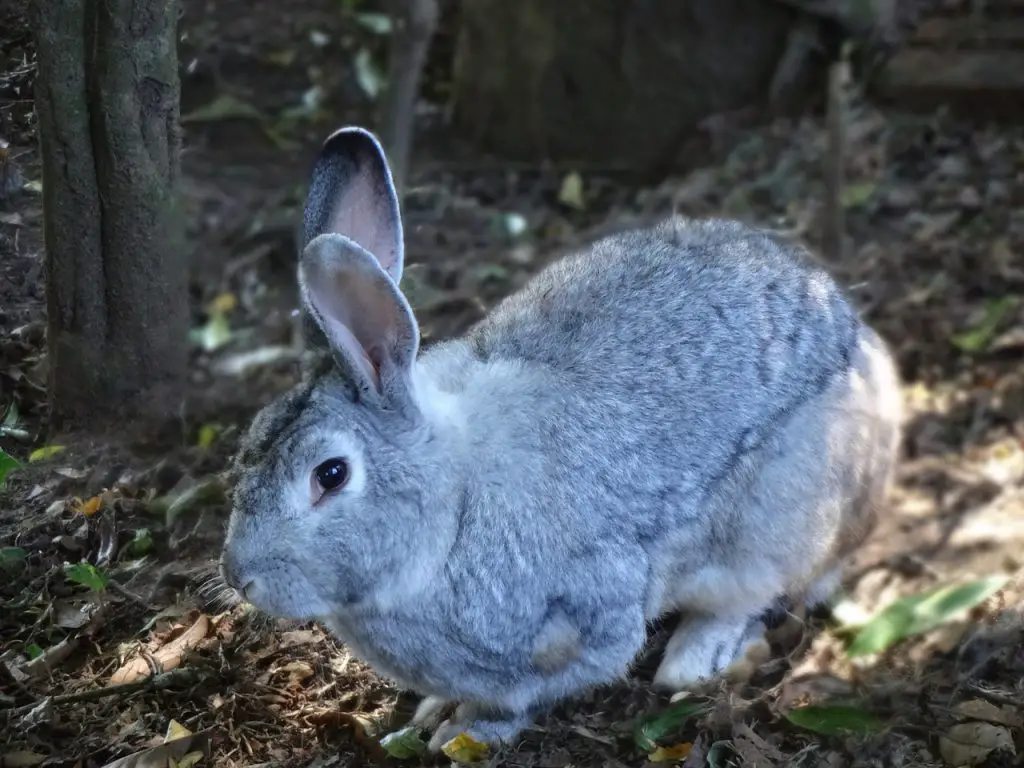
Enclosure
The American Chinchilla rabbits can do great either in an indoor or outdoor enclosure provided that they are not displayed to excessive cold or heat. The outdoor enclosure must be hoisted from the surface to guard them against probable predators and should have a ramp leading to the fenced bottom to help them hop around on the grass underneath. Indoor cages have to be sufficiently huge, so the American Chinchilla rabbits can conveniently stretch out, and knowing their size, these cages have to be rather big, which is exactly the reason why this particular breed is not suggested for people who live in apartments. The enclosures must be built with wire walls and should have a metal or plastic bottom to grasp bedding, which has to be spot-cleaned regularly and entirely changed every weekend.
Climate
American Chinchilla rabbits can tolerate different climates. They are strong and hefty. They have body systems that can adapt and adjust to a new climate with convenience. This means that these rabbits can leave in various weather climates without having to go through some serious concerns. However, rabbits must never be allowed to stay outside if they have no proper housing and shelter that is lifted off the ground and secured from predators.
Toys and Exercise
When talking about playtime, every American Chinchilla rabbit considers toys a bit different. Some rabbits can be perfectly satisfied with customized and DIY toys while some are pleased to use mentally-stimulating toys which are available in any local pet stores. Whatever your choice would be, always see to it that you are using rabbit-safe toys. Also, toys should not break off into portions that your pet can unwittingly swallow and injure themselves inside. Mentioning that, the personality of your American Chinchilla rabbit shall prosper the longer they are exposed outside of their cages inviting and reaching out with their human family. Petting their backs, heads, ears, and necks is fully admissible and very much advocated.
Diet
Owners of American Chinchilla rabbits have to pay special attention to their diet because these creatures have a sensitive digestive system. In terms of the diet of American Chinchilla rabbits, their diet does not vary from other breeds of rabbits. This implies that they have to get a diet that is composed of 70 percent hay, and the remaining portion should be composed of a healthy combination of superior kinds of pellets, leafy greens, fruits, and vegetables. Some leafy greens, fruits, and vegetables are more promising in terms of healthful value to American Chinchilla rabbits, while some must be avoided no matter what happens. Apples, in particular, are a great example of a treat; however, iceberg lettuce does not offer sufficient nutrition to be helpful to the health of the rabbit. It would be wise if you always conduct your study and research when you organize your feeding for your pet and when you are not certain, do not hesitate to seek advice from a veterinarian.
How to Care for American Chinchilla
One great thing about the American Chinchilla rabbits is that they can do great either indoors or outdoors. Nevertheless, you cannot expose these creatures to excessive cold and heat. American Chinchilla rabbits were mostly developed for their meat and pelt during the 1990s, wherefore they are commonly comfortable being handled by people. This implies that these creatures can also make impressive pets for people of different life stages. Although these animals are not suggested for families with young kids, American Chinchilla will make great pets for families having older kids who have the comprehension of how to properly handle the rabbit.
These rabbits are particularly hard to potty-train; however, it does not imply that it is not possible. A lot of rabbit owners have experienced a successful rabbit raising with patience, sufficient time, and plenty of rewards. Some owners have even extended an effort by putting some litter boxes on the sides of their homes, so their pets need not walk far to look for a litter box to carry out the deed. They may consume a long time compared to an average cat or dog; however, rabbits are smart enough to comprehend when they are assumed to carry out a business in a specific area.
If these creatures are adopted at an early age and are familiar to the family members, they can make great pets at home. However, it is essential that you thoroughly educate your children on how to care and treat your pet, particularly with creatures like them that have long ears. If your kids are playing with this rabbit, they must handle it with care and should never pull its ears.
You have to ensure that your American Chinchilla uses a big enclosure or cage where it is provided enough space to move around. The enclosure requires a little nest, a drinking fountain with abundant water, feeder, blankets, and wood for gnawing. You must know that your pet needs something to gnaw into to inhibit the abnormal growth of the teeth. Further, the rabbit has to be brushed at least 2 to 3 times a week, to eliminate dirt and dead hair. It is also crucial to brush the fur of your rabbit to avoid the occurrence of fleas and mites. Your pet should be fed with hay, vegetables, and fruits.
Outdoor areas should be fenced to protect these rabbits from their potential predators. It is always recommended that you introduce your rabbit to your other pets as early as possible. For indoors, come up with a huge rabbit cage to cater to their large body size and also secure a space for their stretching.
You will have to supply your pet a nutritive diet such as hay, superior-quality pellets, vegetables, leafy greens, and fruits. It is best to research the kind of feeds to offer for your rabbit pets to support their fitness. There should be a hiding place for them to escape if they feel anxious. They should be able to evade things that frighten them. Remember that they are prey species.
Where to Get an American Chinchilla
If you are looking for a pet rabbit that can also give you meat, then getting an American Chinchilla rabbit would be best for you. However, you must condition yourself to pay a little bit higher if you are aiming to get a rabbit that is used for showing, purebred, and pedigreed. Considering that American Chinchillas are one of the most peculiar rabbits in America, you may not be able to get it ready. You may do your research from their national club. You may also check on rabbitries, rescue centers, and ARBA approved breeders. Finding them from online listings may help you discover those that are near to your area.
Nevertheless, you should always prioritize the quality and health of the American Chinchilla. You may be able to find these creatures from various sources; however, you cannot immediately decide on whom to transact without doing the basic research. You must get your American Chinchilla from a reliable institution. You would not want to get an American Chinchilla rabbit that has issues with its health.
FAQs
Can I let my kids play with our new American Chinchilla?
Your kids should be guided around these rabbits, and they should be appropriately educated on how to handle these rabbits. American Chinchilla may scratch and bite.
We have a scheduled trip with the family, is it safe to leave my American Chinchilla behind?
As long as you ensure the safety and maintenance of your rabbit, then there should be no problem leaving your American Chinchilla behind. You may consider temporarily boarding your rabbit in someone’s house. You may know someone from your group of friends who would welcome to take your pet, or you may coordinate with a local House Rabbit Society for a volunteer who would accept boarding your rabbit.
Is it necessary to neuter/spay my American Chinchilla?
Yes. Neutering or spaying your American Chinchilla rabbit would lessen the gnawing behavior, lessens territorial invasion, and shall provide your pet a happier and longer life.
Do American Chinchillas get vaccinated?
Yes. Your American Chinchilla rabbit has to visit a veterinarian every 6 months to get vaccinated. This is essential if you want to prevent your pet from acquiring diseases. You would rather want to prevent these serious illnesses than having to go through the stress of handling a sick pet.
Why is it recommended to put my American Chinchilla in an indoor home?
Remember that American Chinchilla rabbits are prey animals. This means that they can be hunted by cats, dogs, and snakes. They are very vulnerable to the bites of insects too. Keeping the rabbit in an indoor home can give them much security and protection.
